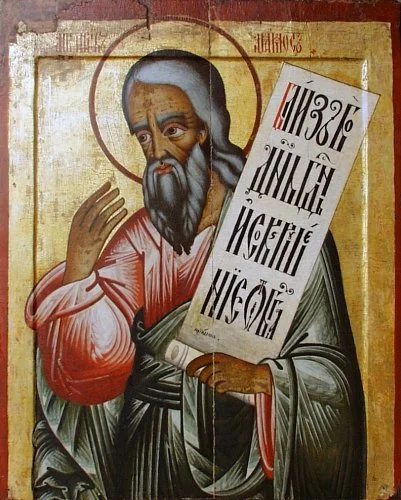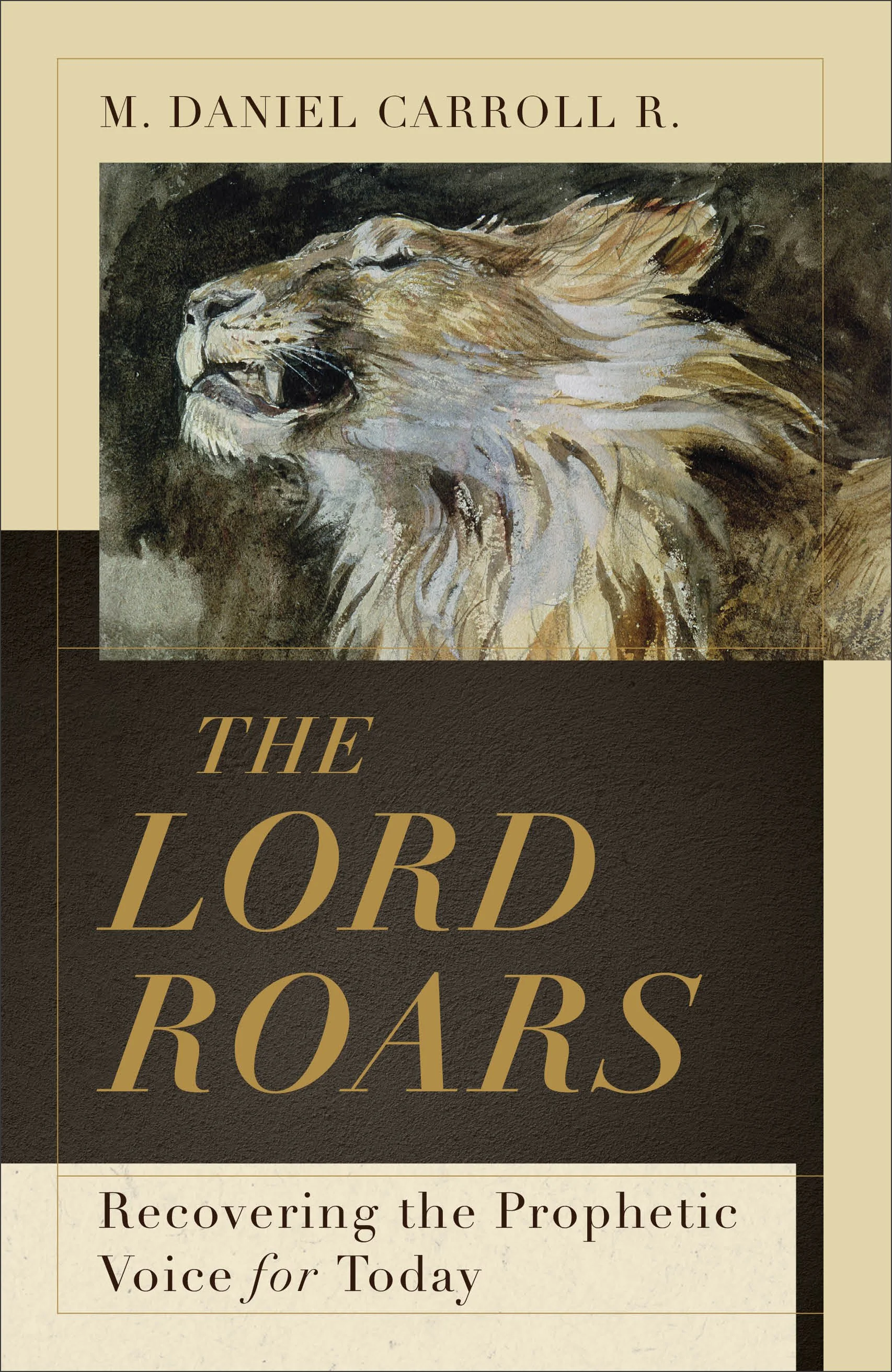The Lord Roars
Dr. M. Daniel Carroll Rodas presents excerpts from his new book on recovering the prophetic voice for today
“The Prophets,” one of nine stained-glass windows installed in the sanctuary floor of the New York Avenue Presbyterian Church, Washington, DC: “It has been said that the prophets are ‘the beating hearts of the Old Testament.’ Here Isaiah, Micah and Amos call the people of Israel to renewed faith and justice. Towering skyscrapers remind us that the prophetic word must still be spoken” (Paul Dornan). Source: New York Avenue Presbyterian Church
EDITORIAL NOTE
The feature below is excerpted from The Lord Roars: Recovering the Prophetic Voice for Today (Baker Publishing Group, 2022) by M. Daniel Carroll Rodas ©2022. Used by permission of Baker Academic.
The Preface and Chapter 1- “Reimagining Reality: The Power of the Prophetic Text” can be read here [PDF].
The exclusive excerpts below are drawn from Chapter 2- “Prophetic Critique: Deconstructing the Unacceptable” and from Chapter 3- “‘Let Justice Roll Down’: Worship and Social Responsibility,” with images and links curated by HTI Open Plaza.
The Sociopolitical Prophetic Indictment Today
Amos, Isaiah, and Micah denounced injustice in Israel and Judah. Each prophetic book, in its own unique way, communicates its message through powerful imagery and vignettes of confrontation. Their condemnatory words underscore foundational theological truths that should stimulate reflection on possible prophetic tasks by the faithful today.
To begin with, these prophets shed light on what Heschel calls the “monstrosity of injustice.” They reveal the depths and the breadth of human cruelty and point to the hubris endemic to humanity as a key factor in injustice. This arrogance breeds attitudes, actions, and systems that enable the domination of others, and violence in its different forms often is the tool employed to maintain that injustice. Amos, Isaiah, and Micah did not limit their critiques to a few individuals or to the elites, although they were primary targets; these sins also were culturally and concretely systemic. Injustice infused multiple dimensions of national life.
The first lesson to grasp, then, is that the prophetic imagination (and the entire Old Testament) has an expansive appreciation of sin, which can help us recognize how pervasive and cruel it is and that it is individual, social, cultural, structural, national, and international. It permeates every sphere of life, every group, every structure, every person. It is not difficult for us to point to unsavory individuals or groups whom we might know or who appear in the news. The fact that few transgressors are named by the prophets but instead are identified by their ongoing activities or speech allows us to make those analogies quite easily. Personally or through other means, like the media, we know of people who mistreat the vulnerable, corrupt the legal process, show disdain for those who are of little consequence to them, and lead countries to war. Although twenty-first-century societies are quite different from ancient Israel, these character types persist across time and space. The text readily comes to life.
More difficult, and potentially unnerving, is the awareness of the broader realities of systemic injustice and cultural and national sins sparked by reading these prophetic books. Again, our world is not that of Israel’s prophets, but these many dimensions of sin are a reality in every age. Although the mechanisms are not the same, the wheels of injustice still grind down the vulnerable. Examples of structural sin in the United States include race relations, mass incarceration, educational inequities, housing restrictions, and irregularities in voting rights and law enforcement. To these could be added the arrogance and lifestyles of the political classes, the discrimination endured by women, the tragic treatment of Native Americans, the checkered history of immigration and immigration law, intolerance toward Latino/a and Asian and Asian American communities, as well as the horrors of human trafficking, the opioid epidemic, and more. Each form of injustice has its own particular history and victims and spreads its tentacles into every corner of life, making everyone at some level a complicit participant. The prophetic lens into human sin allows us to see the evils around us and to acknowledge that we inhabit a perverse social construction of reality. In so doing, we see the world truly. Whatever one’s position on any of these issues, a prophetic vision recognizes the full reality of human evil and its cancerous presence. This more accurate perception is not a neutral exercise, which leads me to my second point.
The prophetic imagination is a disturbed one, one upset at injustice. But this is a theologically informed anger. In Amos, Isaiah, and Micah, prophetic invective is rooted in an extensive knowledge of the person and actions of Yahweh. Fundamentally, their rebukes are connected to the pathos of Yahweh. That is where legitimate prophetic emotion finds its source. Grounded in a divine call and bathed in scriptural traditions, the prophetic message was God’s. This raises issues that those who claim the prophetic voice today must face honestly: What ultimately drives our prophetic passion? Is it the biblical text and a deep theology, or is it drawn more from a particular political ideology with its set of partisan commitments that determine what can and cannot be talked about and how? To what degree might it reflect the often acerbic and deliberately polarizing outlets of social media? Are the targets of our prophetic accusations determined primarily by a political party and its platform? Is our fund of texts limited to a few frequently quoted passages that can become slogans (e.g., Amos 5:24; Isa. 61:1; Mic. 6:8), or does our biblical foundation extend more broadly? To speak prophetically well is to be versed in the biblical text that gave birth to this voice.
But let justice roll on like a river, righteousness like a never-failing stream!
—Amos 5:24
Image: The Prophet Amos, in a painting from the first quarter of the 18th century. Source: Iconostasis of the Church of the Intercession, Kizhi Island, Russia
Third, the prophetic imagination is committed and constant. In addition to the insights that it provides, a prophetic vision can motivate us to speak and act against wrong and the hubris that drives it. The prophetic stands in solidarity with and for the vulnerable and against perpetrators of injustice and sinful systems. But—and this is crucial—our prophetic texts do not tell us how to fulfill this task in the twenty-first century. In these books we are given snapshots of what ancient prophets experienced in their contexts, not directives. In other words, we are left with a general mandate to denounce wrong. The prophets provide important theological grounding and a moral compass, but not policy blueprints. It is up to us to process what the prophetic imagination and course of action might look like today. These prophetic books also demonstrate that such involvements provoke reactions of various kinds (confrontation, silencing, marginalization), even from religious leaders and institutions. In these texts we see debates over the demands of the faith, the meaning of theological traditions, and the authority to speak. This always is the experience of the prophetic voice. With prophetic commitment will come clash.
A fourth lesson relates to the inclusion of judgment in the prophetic vision. This judgment may come via the organic processes of the moral constitution of creation or through other forces. Unlike the ancient prophets, however, we are not privy to the council of Yahweh (Amos 3:7). We cannot foretell the means or timing of divine judgment—even the biblical prophets did not predict dates—but we do know that one day it will come. It must, or prophetic denunciation loses credibility and is reduced to loud protest. Because they think God cannot see (even if they believe that he exists), the guilty must be told that they cannot trust their plans. Their sin matters to God, and there is a price to pay for injustice. At the same time, the victims of injustice need to hear that Yahweh has seen their suffering and heard their cries; they need to trust that one day God will act on their behalf and punish evildoers. Sinful cultures must realize that God will hold longstanding sinful attitudes, words, actions, and systems to account; nothing and no one are beyond God’s reach. Ours must be a diatribe against evil and a declaration of divine intention.
Fifth and last, a full prophetic perspective requires more than critique. To denounce and deconstruct is one thing; to seek the repentance of the transgressors and the culture at large, or at least some admission of wrong that might recalibrate their perception of the world, is another (and perhaps costlier) challenge. For instance, even though he knew that Israel was guilty of sins at many levels and was deserving of punishment, Amos interceded with Yahweh to be merciful in judgment (7:1–6).
This aspect of the prophetic call always has been a quandary for those seeking change. How much time and effort does one dedicate to this often frustrating and fatiguing process in personal relationships, the workplace, education, and the public square? Martin Luther King Jr. constantly dealt with this facet of his prophetic ministry, as have many others, but dealing with passivity or opposition is part of incarnating the prophetic vision. The biblical prophets do eventually reach a point when they cease such gestures and pronounce definitive and inescapable judgment—but Yahweh never gives up on his people or the nations, even when decreeing judgment. The warnings and the judgment were designed in part to have transgressors, indeed entire nations, bend the knee, and there always was a message of a hope beyond the time of divine visitation. How to adjudicate this dimension of the prophetic must be determined on a case-by-case basis.
The Spirit of the Sovereign Lord is on me, because the Lord has anointed me to proclaim good news to the poor.
He has sent me to bind up the brokenhearted, to proclaim freedom for the captives and release from darkness for the prisoners…
—Isa. 61:1
Image: The Prophet Isaiah, in a painting from the first quarter of the 18th century. Source: Iconostasis of the Church of the Intercession, Kizhi Island, Russia
The Prophetic Vision and Worship Today
Worship has become a popular topic in recent years. In North America discussions have revolved around, for instance, styles of worship, and a variety within evangelical and mainline Protestant traditions vie to be both true to the tenets of the Christian faith and relevant to an ever-changing culture. Progressive voices, calls for multiethnic churches, and the new monasticism, among others, are seeking to reformulate worship in ways that resonate with their commitments. I do not minimize these important considerations. I would like to focus the conversation, however, in a particular direction.
At least two concerns requiring careful reflection arise from the critique of religion in Amos, Isaiah, and Micah. The first is the matter of idolatry, which we introduced earlier in this chapter. Recent works on idolatry that have church leaders and lay people as their target audience commonly identify as idols aspects of the culture that draw believers away from a more singular commitment to the God of Scripture, because these items respond to people’s fears or aspirations. Cultural realities that commonly are mentioned include consumerism and prosperity, entertainment and social media, nationalism, and self-actualization, all of which have their own appointed spaces, regular activities and rhythms, vocabularies and talking points, gurus, and rewards— and all have seeped into the life and worship of the church. These observations are correct up to a point, but they can miss the essential issue at stake in worship, which is the person of God.
Our three prophets battled erroneous understandings of Yahweh and belief in other deities that impacted the people’s understanding of God. Israel and Judah were supremely active religious nations, but the quantity of rituals did not qualify the worship as acceptable. From the prophets’ perspective, these activities were directed at another god constructed according to the worshipers’ tastes and needs. Their religion, in all of its expressions, had been co-opted by cultural givens and national ideologies. The people crowded the sanctuaries for worship, but they were petitioning and praising the communal idol they called Yahweh, who they thought would preserve their societies, bless them with bountiful crops, and secure victory for their armies. Their religious world was a complex lie sustained by religious practices and institutions. This explains why these prophets attacked the religious leadership, those who were charged with leading the people to true faith, and announced the destruction of the central sanctuaries. Reorienting the people’s view of Yahweh and thus their social construction of reality would require the end of religion as they knew it before there could be a fresh encounter with the true God. Yahweh would not be mocked.
However one evaluates Latin American liberation theology, these theologians grasped this essential issue as they wrestled with the classic theological formulations of their tradition in the effort to address injustice and despotic dictatorships. Appealing to the category of idolatry, Pablo Richard says, “The fundamental theological task in Latin America is not so much to prove the existence of God, but rather how to discern the true God from false idols. The problem is not to know if God exists, but to demonstrate in what kind of God we believe.” This is akin to the prophetic charge long ago in their ancient contexts, and it remains so today.
He has shown you, O mortal, what is good.
And what does the Lord require of you?
To act justly and to love mercy and to walk humbly with your God.
—Mic. 6:8
Image: The Prophet Micah, in a painting from the first quarter of the 18th century. Source: Iconostasis of the Church of the Intercession, Kizhi Island, Russia
What we witness in debates over coordinating current justice issues with the meaning and viability of the label “evangelical,” over the substance of curricula in theological and ministerial training, over denominational histories and their future direction, over sociopolitical alignments and involvements, and the like is, at bottom, a struggle over the identity of the God we worship and the relationship of that God to matters of justice and compassion. This is a messy, stormy time of friction and hyperbole, of soul-searching and vitriol, of personalities and agendas, of institutional inertia and reform. This is a necessary travail, another moment in the history of the Christian church in this country in which to wrestle with the questions about who Yahweh is and what he requires of us. The Spanish word coyuntura is apropos here. A coyuntura is a moment when things come together in an important way. The church faces a significant coyuntura today. These struggles in the case of the prophets were intertwined with an unwavering commitment to the people of God. They were his people despite everything. So today, in our coyuntura, the prophetic voice ideally remains committed in some way to the church.
These difficulties lead to the second issue for reflection, which is the role of liturgy in getting God right. There are a number of Old Testament scholars who are aware of the power of liturgy and its relationship to ethics and whose work is important. Their work can be correlated with perspectives on liturgy developed by several theologians.
To begin with, there is no such thing as a nonliturgical church. Even those who claim to eschew liturgy congregate at the same time and place, consistently structure the service in the same way each Sunday (or Saturday), celebrate Christian ordinances (such as baptism and the Lord’s Table) in a regular manner, use a standardized religious vocabulary and music repertoire, and contract religious personnel. It is more correct to say that these churches do not follow one of the historical liturgies of the church, but they do have a liturgy. What follows, then, applies to all Christian churches.
Liturgies, whatever they may be, are deeply instructive and formative. Liturgies are instructive in that they project and inculcate a certain understanding of God and a vision of the world and of the life of the people of God in the world. They do this through their various components (prayer, singing, the spoken word, the Lord’s Table, and other features, depending on the church tradition). These activities, in the language of virtue ethics, are practices that shape—consciously or unconsciously—the dispositions, habits, and character of the participants. These formative and instructive dimensions are inseparable; they mutually reinforce and build off one another.
In Amos, Isaiah, and Micah worship is flawed—not because it was not done according to historic scripts or because of a lack of passion. Rather, the God of Israel’s and Judah’s worship was not Yahweh. Their religious practices were producing and legitimating societies of greed, corruption, socioeconomic casualties, and national arrogance that were unacceptable to Yahweh and deserving of judgment. The creation of a culturally and ideologically pleasing God had yielded a world that the prophets condemned.
There is much here that carries over to our day. In light of what we have seen in Amos, Isaiah, and Micah, the essential question for a worship service must not be, as it often is, Did you like it? The questions that need asking are, What is the God of this worship like? Does this worship shape the congregants to be and live commensurate with the God of the prophets? If justice and compassion are part of the essence of who that God is, then are the people of God more just and compassionate because they have worshiped? If not, why not? Discussion about worship now moves into considering how it might contribute to creating a people of virtue. Evaluation is based less on musical excellence, beautiful venues, technologies, growing numbers, or emotional appeal but instead on faithfulness to this God at home, in the workplace, and on the street—a faithfulness visible in the virtues of justice, peace, hospitality, and solidarity as a testimony of and testament to the living God. A people thus formed and grounded are less likely to be compromised by cultural trends and the political persuasions of the Left or the Right. They will be more sensitive to the influences that corrupt the biblical vision of God. They will have a substantive counternarrative to unmask captivating cultural stories. Worship becomes inherently deeply confessional and missional.
For marginalized groups, worship can be a haven, a time and place to heal congregants of the many difficulties of living as a minority or to provide social services or to organize for community and political projects to respond to concrete needs. Yet these churches cannot be idealized. They, too, can be influenced negatively by cultural and ideological trends and so compromise the faith.
I am not advocating a particular worship style. Instead, the plea is to align worship with the prophetic imagination, which demands that it present the biblical God and be a means of creating a community of faith as it was designed to be. Stanley Hauerwas is correct when he observes the serious consequence of bifurcating liturgy from ethical responsibility: “When liturgy becomes a motivation for action that does not require the liturgy for the intelligibility of the description of what we have done, then we lose the means as Christians to make our lives our own.” Liturgy should not just encourage us to act justly and with compassion. It must make evident that these virtues define who we are because this is who our God is.
“The Lord Roars has helped me see how the prophetic imagination in the canonical biblical text can orient my motivations to see theologically and work ethically toward a better world. From a hermeneutic of trust, Carroll invites the reader to carefully consider what the word of God offers as a witness to a more just and less violent world conceived through theo-poetic justice. Manifestly, Carroll's proposal challenges today's Westernized Christian visions of a world trapped in left-wing and right-wing political ideologies."
Oscar García-Johnson
Associate Professor of Theology and Latinx Studies; Chief of Diversity, Equity, and Inclusion; Fuller Theological Seminary
The Lord Roars: Recovering the Prophetic Voice for Today by M. Daniel Carroll Rodas (Baker Publishing, 2022)
Recovering the Prophetic Voice for Today: Dr. Jean-Pierre M. Ruiz talks to Dr. M. Daniel Carroll Rodas about his new book The Lord Roars







